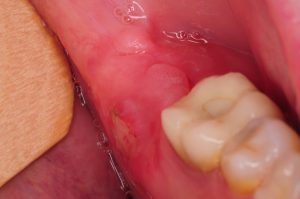 A rare condition following extraction of wisdom teeth is known as lingual bone dehiscence (bone exposure). This is not a complication, but rather a healing condition related to exposure of the bone on the inside aspect of the ridge. The primary reason for this condition is the characteristically thin gum tissue in this area of the jaw bone as well as the socket expansion that can occur during the extraction process. Days following the extraction, patients may notice a hard or sharp area of bone which can quickly cause irritation to the side of the tongue resulting in pain.
A rare condition following extraction of wisdom teeth is known as lingual bone dehiscence (bone exposure). This is not a complication, but rather a healing condition related to exposure of the bone on the inside aspect of the ridge. The primary reason for this condition is the characteristically thin gum tissue in this area of the jaw bone as well as the socket expansion that can occur during the extraction process. Days following the extraction, patients may notice a hard or sharp area of bone which can quickly cause irritation to the side of the tongue resulting in pain.
There are several treatment options for lingual bone dehiscence related to wisdom teeth extractions:
- If there is a sharp bony ledge: The sharp bony area is removed and filed down to make it smooth. The gum tissue gradually heals covering the exposed area of the bone in 2-3 weeks.
- If there is exposed bone only (smooth with no sharp edges): Two treatment options:
- Sequestrectomy / osteoplasty: The bone is filed down to reduce its thickness in the exposed region and allow the gum tissue grow over the area.
- Observe and delayed removal of the bony segment: Given enough time (usually 4-6 weeks) the exposed bone may become loose by itself (a process known as involucrum). During this period, new gum tissue forms under the exposed bone and the body gradually expels the bony segment. This segment becomes gradually loose which can then be simply removed.
The gum tissue generally fills in 2-3 weeks and remodels completely in 6-8 weeks. No antibiotics is generally needed. Soft or liquid diet is encouraged for 10-14 days to avoid trauma to the healing site. Patients should rinse with salt water every 2-3 hours. A close observation by an oral surgeon is recommended during this healing period.
Dr. H. Ryan Kazemi is a board-certified oral and maxillofacial surgeon in Bethesda, MD